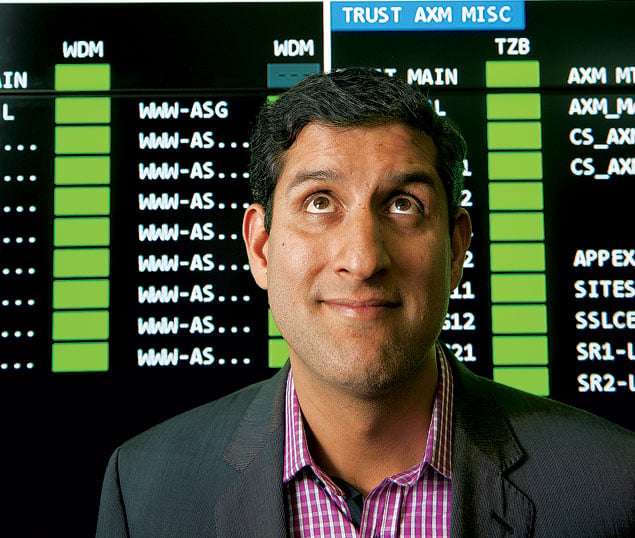If the vision of information technology offered by a Dulles Corridor start-up resembles the sleek elegance of an iPhone, government computing can look more like a dial-up modem.
The Census Bureau inked a $600-million contract for hand-held computers to conduct the 2010 count, then had to go back to paper when the project went over budget and fell behind schedule. The FBI put $170 million into one failed attempt to computerize its case files and has since plowed more than $400 million into a successor effort with disappointing results. But the worse failures may be those that don’t make headlines: the obsolete hardware and software inflicted daily on government workers who use far better technology at home.
To help fix IT in Washington–an $80-billion annual expense–President Obama turned to the District, appointing Vivek Kundra, DC’s chief technology officer, as the nation’s first chief information officer.
Kundra, 37, began his government career as Arlington’s director of infrastructure technologies from 2001 to 2003, then as Virginia’s assistant secretary of commerce and technology from 2006 to 2007, with two private-sector stints in between. But he made a name for himself innovating in DC.
Starting in March 2007 as then-mayor Adrian Fenty’s chief technology officer, Kundra switched DC government offices to Google’s cloud-based services and pushed agencies to publish data such as crime statistics in an easily searchable form on the Web.
By hiring Kundra, President Obama hoped to see a similar reboot of federal IT. To some degree, Kundra delivered–terminating overdue projects, consolidating data centers, creating cloud-computing strategies, and pushing a growing selection of government statistics and metrics to information portals such as Data.gov.
But he also hit obstacles. An August survey of government IT professionals by the online network MeriTalk gave Kundra only a B grade, with better marks for inspiration than for implementation.
A more accurate grade might be “incomplete.” In August, Kundra left his post as federal CIO for a fellowship at Harvard’s Kennedy School and Berkman Center for Internet & Society. This winter, he took a position as executive vice president of emerging markets for Salesforce.com, a San Francisco firm that provides Web-based marketing, service, personnel, and other services to businesses.
Over coffee at a hotel in Rosslyn, he talked about what he’s learned.
What was it like to move from city and state government to the federal level?
What you’re instinctively overwhelmed with in the beginning is the scale of the federal government. You’re looking at 12,000-plus major IT systems. And then you look at the budget–$80 billion in technology spending. But even the federal government doesn’t violate the laws of physics, so to speak, when it comes to information technology. It’s more zeroes, but the problems are very similar.
What about the people?
There was actually amazing talent within the federal government. I think a lot of people make the mistake of focusing on just political appointees or top management. You have some of the most dedicated workers buried away in this vast bureaucracy.
Why do so many of these government IT contracts not work?
On the government side, you basically have a bunch of people who are promoted because they’re there for a long time. It has nothing to do with skill sets. That is one of the reasons, as part of the reform effort, we put in place a program-manager career track. If the customer isn’t really smart, the vendor is going to take advantage of that.
Folks would go into these bids knowing they would lose money initially but would make money on change orders. It’s almost like a business strategy.
One example of inefficiency you found is that the government was running more than 2,000 data centers. So the idea is to close 800 of them.
The ultimate vision would be to actually get to three digital Fort Knoxes. It’s a 10-to-15-year journey to move in that direction. The reality is that there are a lot of legacy systems across the federal government that need to be consolidated. At the same time, there needs to be political will when it comes to Congress to make sure they’re comfortable with shutting down these data centers.
Wouldn’t you still need one in each congressional district?
Victory would be if you had one in every state so you ended up with 50. That would be huge.
What did you learn about selling government agencies on publishing their data–such as White House visitor records, FDA recall orders, and seismic records–for everybody else to reuse?
They want to make sure that as the information is liberated, the consequences of that don’t come back and hurt them.
That is why when we launched the Data.gov platform, it started with only 47 data sets. And sort of going agency by agency, department by department, person by person, making that case, what you saw was a tipping point–where people could see amazing applications created by third parties.
When people would actually see that the value generated was far greater than the downside, over the course of this two-plus-year period we actually saw agencies begin to turn around. But even with 400,000-plus data sets, there are plenty that need to be liberated.
What about the worst-case scenarios–what you’ve called “boil the ocean” projects that never get done?
The way information technology is budgeted is two years out. If you look at agencies right now, they’re probably working on their 2014 budget for information technology. Yet the way technology moves is so fast that in two years you’ll probably have a next version of the iPhone or Droid or BlackBerry.
Because there is this structural problem of how budget is allocated, agencies try to “boil the ocean.” Their view is “If I’m going to get one bite at the apple every two years, let’s try to do everything at once.”
I think procurement in the federal government is broken. It favors incumbents and the status quo over the lean start-ups in terms of its archaic procurement rules and regulations. Most start-ups will tell you they will never come to the federal government and bid because they would go bankrupt trying to understand the procurement process.
Procurement is worse in federal IT?
Congress funds it bureau by bureau, department by department, agency by agency. So you have these sort of vertical lines of funding where IT is most efficient horizontally.
The one area where I wish we’d made more progress was with Congress on actually reforming that. Imagine if we had a committee of technology within Congress that would appropriate centrally. That would be the biggest game-changer in federal IT.
Did you have a problem with individual employees wanting to stick with the obsolete systems they knew well?
What was happening was the opposite. People were asking the right question–which is “If I can get on Expedia or I can get on OpenTable and it takes me minutes to do this, why does it take me half an hour to book a flight on this e-travel system we have within the government?”
That’s the “shadow IT” phenomenon you’ve talked about–workers resorting to consumer tools to get their jobs done.
I think it’s a factor everywhere–federal, state, county, city, you name it, even Fortune 500 enterprises. They’re all going through it.
My view is that most organizations should get out of the business of issuing end-point devices such as computers and smartphones. That’s why I’ve advocated for a cloud-centric architecture, where security should be at the cloud level.
What is it about IT that makes people complain about it so much?
In psychology, there’s this principle of locus of control. Essentially, as humans, the more you feel you have control over your decisions, the happier you will be. What happens is that a lot of users hate IT because they’re forced to take these vanilla boxes.
There’s no competitive advantage to forcing people to standardize. Imagine if you could just say, “Here’s a stipend of $1,500–go buy your laptop, go buy your mobile device, go get whatever plan you want.”
Where does your interest in government come from?
I went into government because I wanted to have an impact and I believed there was a way to really drive change with information technology within the public sector.
I am actually not one of the people who are pessimists when it comes to government and technology overall. I believe that there’s some amazing stuff happening.
You haven’t spent too many years in any one job. What’s led to that quick turnover?
It’s the approach to the job. What I mean by that is that when I took the White House job, there were two ways to do it: treat it like a marathon over a course of multiple years or treat it like the race of your life. At the White House, I was showing up at 4:30 in the morning, leaving at 10 pm, and doing that pretty much every day except Saturday.
You had to work Sundays but not Saturdays?
Not Saturdays–I took Saturdays off.
Between your tenures in Arlington and in Richmond, you worked at a start-up, Evincible Software, and then founded and ran a small shop called Creostar. How do you compare working in the public and private sectors?
It was an amazing experience to be part of a start-up and to try to build within the private sector. At the same time, the public sector’s potential scale of influence and impact is unparalleled.
I would imagine that at many meetings you’ve been the youngest manager in the room. Did you encounter any tension from that?
I remember walking into each of those roles, and I was definitely the youngest person in the room.
In my first set of meetings when I was in Arlington, when I was sitting down with other CIOs, there was probably a sense of “Well, we’ve worked in this role for 30 years or so. Who’s this new person coming into this role and how is he going to drive or tell us what to do?”
My approach to that was to roll with the assumption that at the end of the day it’s not your age, your ethnicity, or your sex that matters but your performance. I always doubled down on making sure that my performance would speak for itself.
How do you assess the health of the Washington tech industry?
If you look at what’s happening in Boston and Austin and you look at the Bay Area and then Washington, the reason you don’t see as much innovation on the Washington side is because of the way the government buys large-scale technology.
Venture-capital and private-equity guys will tell you they encourage all their start-ups to stay as far away from government as possible. The sales cycles are too long, and they basically burn all their VC money trying to go after one contract.
What have you learned about change and how people resist it?
It’s very much like the human body. Change is viewed as a foreign object or a virus, and all the white blood cells in your body attack it. People are very, very comfortable with this notion of continuing the status quo.
At the same time, a lot of people don’t realize that one of the fundamental laws of physics is that everything moves toward entropy, toward disorder. So you have an impact–but in order for it to be sustainable, you’ve gotta make sure the pressure continues.
This article appears in the May 2012 issue of The Washingtonian.
















